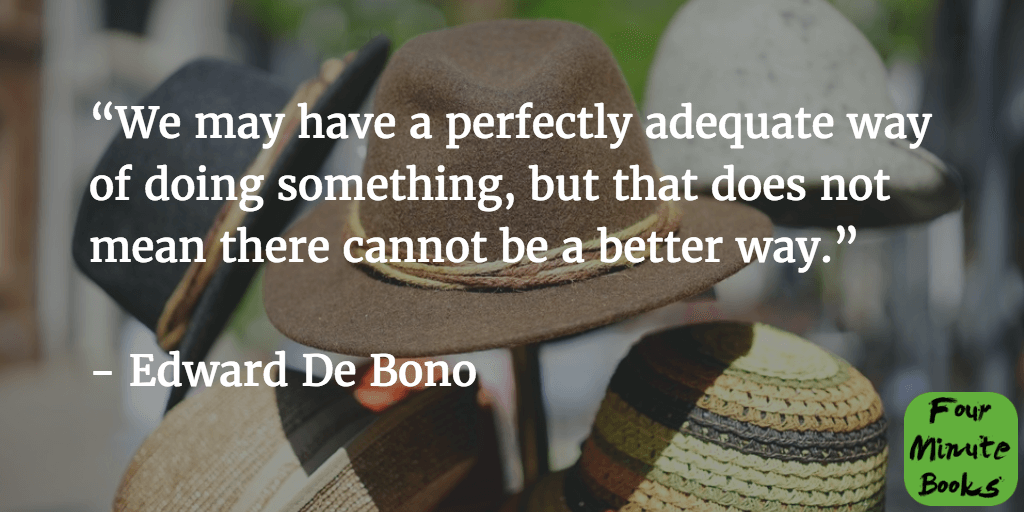1-Sentence-Summary: Six Thinking Hats divides thinking into six distinct areas and perspectives, which will help you, your team, and your company tackle problems from different angles, thus solving them with the power of parallel thinking and saving time, money, and energy as a result.
Read in: 4 minutes
Favorite quote from the author:

Audio Summary
Listen to the audio of this summary with a free reading.fm account*:
Working at a company that gives new management practices, like the Six Thinking Hats Method, a try must be cool. What’s even cooler though, is coming up with such a method, I think!
In 1985, Edward de Bono came up with this way of structuring the thinking process of managers and teams, to help them dissect what’s usually a messy pile of thoughts into useful categories.
The six different hats managers and their teams can take turns wearing are:
- Blue – Management.
- White – Information.
- Red – Emotions.
- Black – Caution.
- Yellow – Optimism.
- Green – Creativity.
This helps members of an organization align their mental process so that they can solve problems with parallel thinking. Here’s a more in-depth look at 3 of the hats:
- The blue hat is the manager’s hat, which is worn to oversee the situation.
- When wearing the red hat, everyone is free to express their emotions without having to worry about being judged.
- The yellow hat gets you to pick up your shovel and start digging, because it’s the hat of the optimist.
Are you willing to experiment with your wardrobe? Let’s try on a couple of new hats!
Lesson 1: The blue hat helps you think about thinking and monitor processes at all times.
Whenever you start a brainstorming session, first put on the blue hat. It’s the hat to think about thinking. Think of it as zooming out and getting a 10,000 foot view on the problem you’re tackling first.
When wearing it, your goal is to answer questions like:
- Why are we here today?
- What’s the scope of the problem we’re trying to tackle?
- Which other hats will we need during the session?
- What are the rules of this meeting?
Since you’re setting up the perimeter of your team effort here, one group member, usually the leader or facilitator of the meeting, will have to keep wearing the blue hat throughout the session, to make sure everyone sticks to the rules.
If that’s you, then it’s your job to tell everyone else when it’s time to switch hats, ask for a conclusion or summary at the end of the session and wrap it up with the concrete, next steps you’ll all take to move things forward.
Lesson 2: It’s important to let employees express their feelings without judgement while wearing the red hat.
Name a couple of things the color red reminds you of. I’m guessing right now you’re thinking of at least one of the following: blood, roses, hearts, lipstick, apples, fire, strawberries, cherries, chilis, tomatoes or a scarf or sweater.
These are some of the things most people think of first when trying to associate the color. If you examine the words more closely, you’ll realize most of them are also symbols of certain emotions.
Blood = Anger, violence.
Fire = Rage or passion.
Hearts, roses, lipstick, strawberries = Love.
It shouldn’t come as a surprise then, that the red hat is the hat of emotion. Whoever wears it should be allowed to freely express their emotions about a situation or problems – without any judgement or explanation.
If you’re running the meeting, don’t ask anyone to explain or justify why they feel a certain way. Just go around the room and have everyone tell their emotional view on the matter. It’s important to include everyone, so no one feels left out and to not judge, so people are comfortable voicing unpopular opinions.
This makes sure no resentment or grudges are carried over into the solution of the problem.
Lesson 3: Without wearing the yellow hat sometimes, it’ll be hard to stay enthusiastic about work projects and get cracking.
Something many people envy me for is that I’m a natural optimist. I get it. This doesn’t come easy to everyone, yet is a huge beneficial factor in overcoming failure, moving on and tackling things with enthusiasm.
Especially after wearing the black hat, where you’re trying to uncover weak points and flaws in your plan, it can be tough to see the potential upside of a plan. However, that’s what the yellow hat is for.
When you’re wearing it, you’re trying to focus on an idea’s positive impact and how it has the power to potentially transform your organization for the better.
This is called being value sensitive, which is when you’re aware that even the most hairy ideas have value. However, one thing to keep in mind is to ground your enthusiasm in realistic expectations.
For example, if you come up with a clever new marketing strategy, don’t fantasize about how it’ll make you a quadrillionaire, just estimate the potential extra business you can make and then get cracking!
Six Thinking Hats Review
I like simple ideas, which you can implement without a ton of training or expensive tools and that lead to a positive effect almost instantly. The Six Thinking Hats Method is one of those ideas. Especially for big businesses with larger teams, I think this can really save a ton of time and money, so if you work at a decently sized company, I highly recommend you take a look at this.
Who would I recommend the Six Thinking Hats summary to?
The 18 year old, who’s annoyed by her theater group’s disorganized management, the 32 year old social media manager, whose team has great ideas, but implements them in a very diffuse way and anyone who sometimes can’t make sense of the chaos in their head.
Last Updated on January 27, 2023